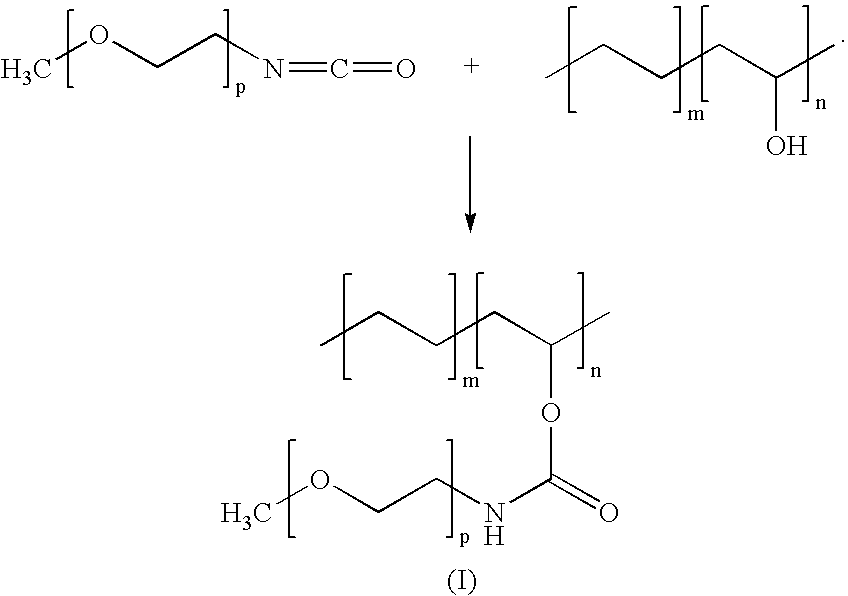Coatings for implantable medical devices
a technology for medical devices and coatings, applied in the field of coatings for medical devices, can solve the problems of significantly inhibiting the polymer's lifetime in vivo efficacy, often causing adverse or toxic side effects for patients, and systemic administration of medication, etc., to achieve the effect of reducing the number of patients, and reducing the risk of infection
- Summary
- Abstract
- Description
- Claims
- Application Information
AI Technical Summary
Benefits of technology
Problems solved by technology
Method used
Image
Examples
example 1
Modifier: poly(ethylene glycol)
[0021] Poly((ethylene glycol) (PEG) is a highly biologically compatible product. Due to the presence of hydroxyl groups, PEG is capable of entering reactions of condensation with EVAL. The reaction may need to be catalyzed by a suitable acidic or basic catalyst. PEG can be in an oligomeric or polymeric form and can have a molecular weight within a range of between about 500 and about 30,000 Daltons. The conditions under which this reaction is conducted can be determined by one having ordinary skill in the art. EVAL can be firmly bonded to the biologically compatible PEG. Thus, EVAL is modified by PEG and the modified EVAL can have an enhanced long-term biocompatibility.
example 2
Modifier: poly(ethylene glycol)-isocyanate
[0022] Poly(ethylene glycol)-isocyanate (hereinafter, PEG-ISO) is a PEG based product having the isocyanate fragments —N═C═O. An example of a PEG-ISO suitable as a modifier for EVAL is a methoxylated PEG-ISO. The PEG-ISO has a general formula CH3—[O—CH2—CH2]p—N═C═O. This modifier, manufactured by Shearwater Corp. of Huntsville, Ala., has a molecular weight of about 5,000 which corresponds to the value of the integer “p” of about 112. Due to the presence of the isocyanate groups, PEG-ISO is chemically very active and readily reacts with EVAL in solution. The —N═C═O group of PEG-ISO, having strong electron accepting properties, reacts with the nucleophilic hydroxyl group of EVAL, as illustrated by reaction scheme (I):
[0023] The conditions under which reaction scheme (I) is conducted can be determined by one having ordinary skill in the art. As a result, EVAL is firmly bonded to the biologically compatible PEG-ISO to form the urethane produc...
example 3
Modifier: poly(ethylene glycol)-epoxide
[0024] Poly(ethylene glycol)-epoxide (hereinafter, PEG-EPO) is a PEG-based product having epoxy fragments. An example of a PEG-EPO suitable as a modifier for EVAL is a methoxylated PEG-EPO, such as methoxy-PEG-glycidyl ether and has the following general formula
The PEG-EPO has a molecular weight of about 5,000, which corresponds to the value of the integer “p” of about 112, and is manufactured by Shearwater Corp. of Huntsville, Ala.
[0025] Epoxy groups in PEG-EPO are reactive, and PEG-EPO easily reacts with EVAL in solution. The epoxy group of PEG-EPO can react with the nucleophilic hydroxyl group of EVAL, via the nucleophilic substitution reaction SN2. Normally, the proton of the hydroxyl group attacks the less substituted α-carbon atom of the epoxy group. The β-carbon is less accessible due to the steric hindrances. As a result of the proton attack on the α-carbon atom, the ring opens, and the modified EVAL is formed according to a reacti...
PUM
| Property | Measurement | Unit |
|---|---|---|
| molecular weight | aaaaa | aaaaa |
| molecular weight | aaaaa | aaaaa |
| molecular weight | aaaaa | aaaaa |
Abstract
Description
Claims
Application Information
 Login to View More
Login to View More - R&D
- Intellectual Property
- Life Sciences
- Materials
- Tech Scout
- Unparalleled Data Quality
- Higher Quality Content
- 60% Fewer Hallucinations
Browse by: Latest US Patents, China's latest patents, Technical Efficacy Thesaurus, Application Domain, Technology Topic, Popular Technical Reports.
© 2025 PatSnap. All rights reserved.Legal|Privacy policy|Modern Slavery Act Transparency Statement|Sitemap|About US| Contact US: help@patsnap.com



